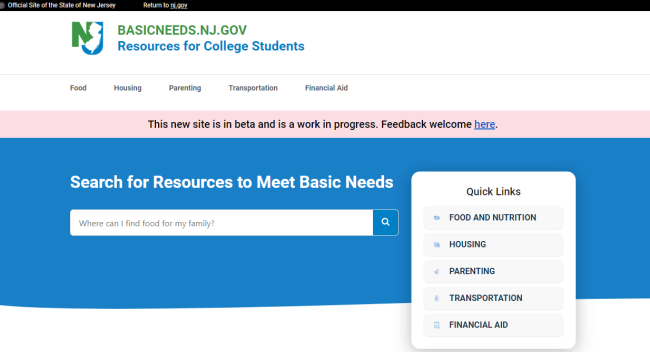You have /5 articles left.
Sign up for a free account or log in.

A new website hosted by the state of New Jersey helps students find services to address basic needs insecurity.
State of New Jersey
The Office of the Secretary of Higher Education (OSHE) in New Jersey launched a website to provide college students with easy access to basic needs support. The site provides a one-stop shop for identifying different types of aid, including help with transportation, housing and food, and eligibility requirements surrounding each facet.
The new resource was announced at a Nov. 17 event at Kean University and has since been shared on local institutions’ websites, including those of Ramapo College, Camden County College, Centenary University and Seton Hall University.
What’s the need: Basic needs insecurity affects college completion nationally, and New Jersey is no exception to the trend. A 2019 survey of New Jersey’s 18 community colleges found 39 percent of students experienced food insecurity and 44 percent experienced housing insecurity. Among those facing basic needs insecurity, 70 percent also could not afford childcare.
A Rutgers University at New Brunswick study completed that same year found 41 percent of undergraduate students experienced basic needs insecurity and 20 percent of undergraduate students experienced housing insecurity.
The background: OSHE staff partnered with the New Jersey Office of Innovation to create the tool, collecting responses from more than 900 individuals.
Stakeholders contributed various resources from various community-based organizations, nonprofit and state agencies to serve as a tool for college students, residents and institutions of higher education in New Jersey.
“Although this website is designed to connect college students to basic needs supports, all New Jersey residents can utilize and benefit from its resources,” OSHE’s website says.
The website is also part of a larger Resident Experience Initiative in New Jersey to improve the state’s services to residents.
How it works: The site has various navigation tools, including five categories of services (food, housing, parenting, transportation and financial aid) and a search bar, which offers suggested prompts for users, including “How can I get help with transportation to school?” and “Where can I find food for my family?”
In addition to the five main categories, the website also highlights health resources, tax assistance, education-related resources and legal aid.
When a student selects a category, they’re given the option to identify specifically what they need. For example, a student can select short-term food assistance for that given week and receive timely information that corresponds to their county.
Webpages also provide information to explain norms around using services, such as what to expect when using a food pantry, eligibility requirements for visiting a shelter or considerations for identifying transportation solutions.
The site does not provide specific advice for the student but rather serves as an aggregate of what is available from a number of providers in one unified space.
What’s next: The website will continue to be developed, and users can provide feedback via an online survey to assist. OSHE staff will also be adding more resources and programs.
Do you have a wellness tip that might help others encourage student success? Tell us about it.




